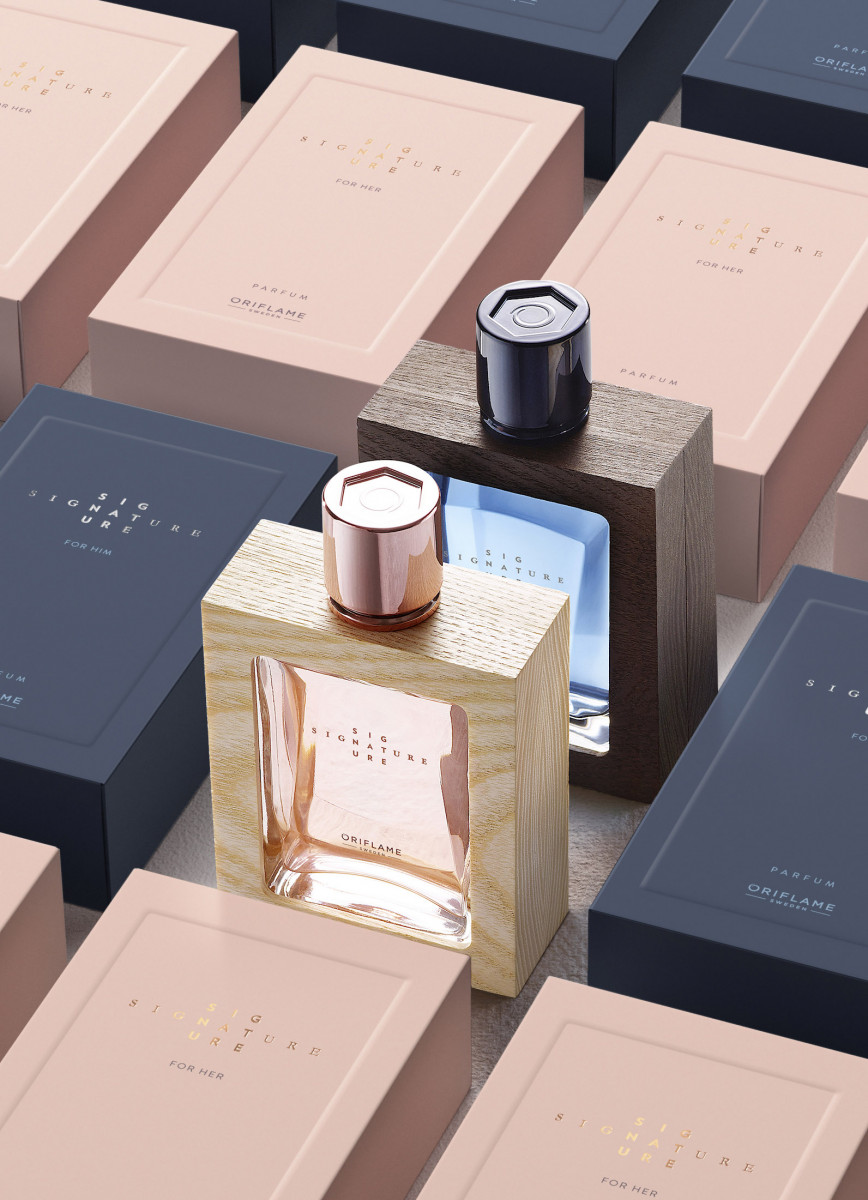
Thoughts,
PACKAGING
WITH (DUAL) PURPOSE
Cosmetics Business Magazine talks to Butterfly Cannon about working with beauty brand Oriflame and the benefits of packaging with an innovative second life
Product packaging that can be more than one thing, encouraging consumers to extend a pack’s life from mere months to decades, is one route to sustainability and an exciting opportunity for designers to flex their creative muscle.
A new example in the beauty sphere was recently launched by Swedish beauty label Oriflame Cosmetics. To create the brand’s Signature fragrances for men and women, Oriflame’s master perfumer worked alongside his son in a highly personal project using traditional ingredients and extraction techniques.
A London-headquartered design firm and long time partner of Oriflame, Butterfly Cannon, was approached to build a brand around the concept of connecting with those closest to you – and to integrate this ethos into the packaging design.
Butterfly Cannon interpreted this as a faceted glass bottle encased within a sleek wooden frame, designed to be removed and reused as a photo frame for memories of loved ones.
“[Oriflame’s] concept was loosely about those closest to you and family,” explains Chris Joscelyne, Marketing Manager at Butterfly Cannon. “Then we worked with them and came up with this idea of generations working together for the future. That was the story we wanted to tell.”
DESIGNING IN SUSTAINABILITY
Speaking to Cosmetics Business about the project, Jenny Greenwood, Butterfly Cannon’s Innovation Manager, stressed how important it was to develop an inherently sustainable pack, even if the intention was for long term, or even lifetime use.
“What’s crucial is, if you’re thinking of something that’s going to be repurposed, there are two things you need to look at: how long will it be [used] for, and what is the likelihood of people taking it up? Then you need to market it [as being repurposable] as well. That’s so crucial: how do you display that in your design? How apparent is it?”
A second-life pack should not only be built to withstand the test of time, but, in the event that not every consumer wants to use the packaging for its intended repurpose, Greenwood maintains that solutions should be easy to dismantle for recycling purposes.
A case in point, the Oriflame Signature pack’s frame, in respect of the brand’s own sustainability pillars, uses FSC-certified wood and is monomaterial, designed for ‘friction fit’ without glue or magnets.
This is why, says Greenwood, “working with the correct kind of suppliers is so integral, because [with friction fit] the tolerances have to be so, so tight for it to work”.
But hard work at the creation end means separating the parts is easier for the final user, resulting in satisfied customers, greater uptake of the photo frame concept and (if this concept is not jumped upon) greater recycling compliance.
“So many packs in your house will say ‘separate to dispose or recycle’, but they might not tell you what the separation is,” says Greenwood.
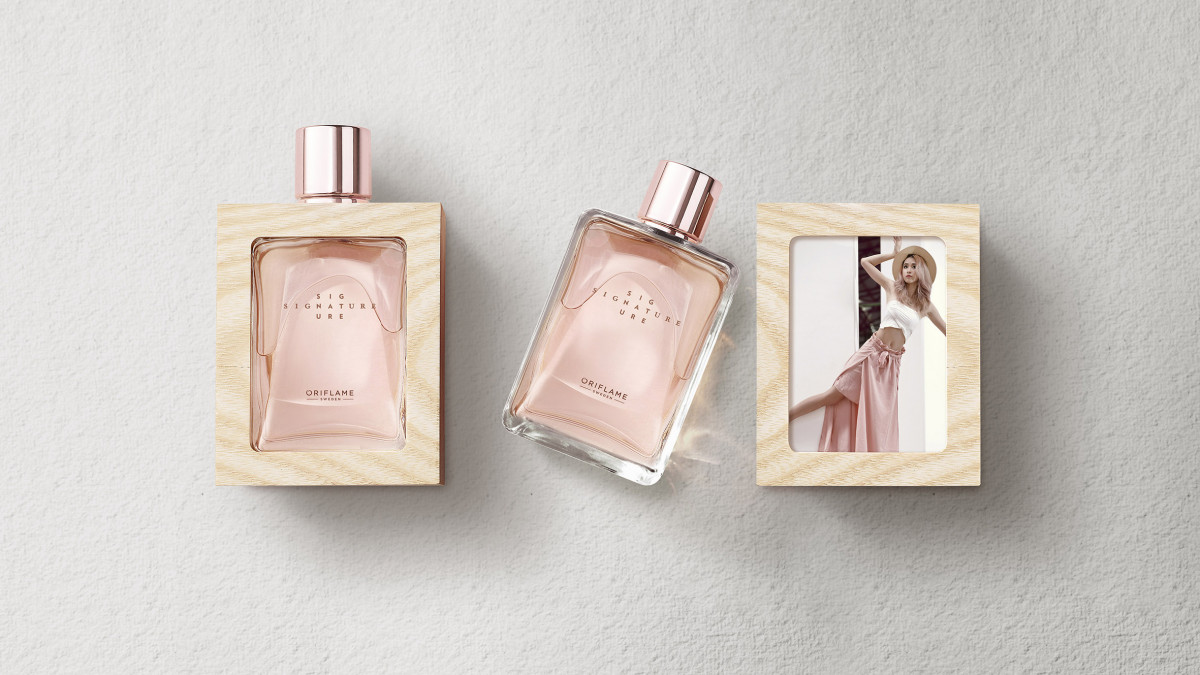
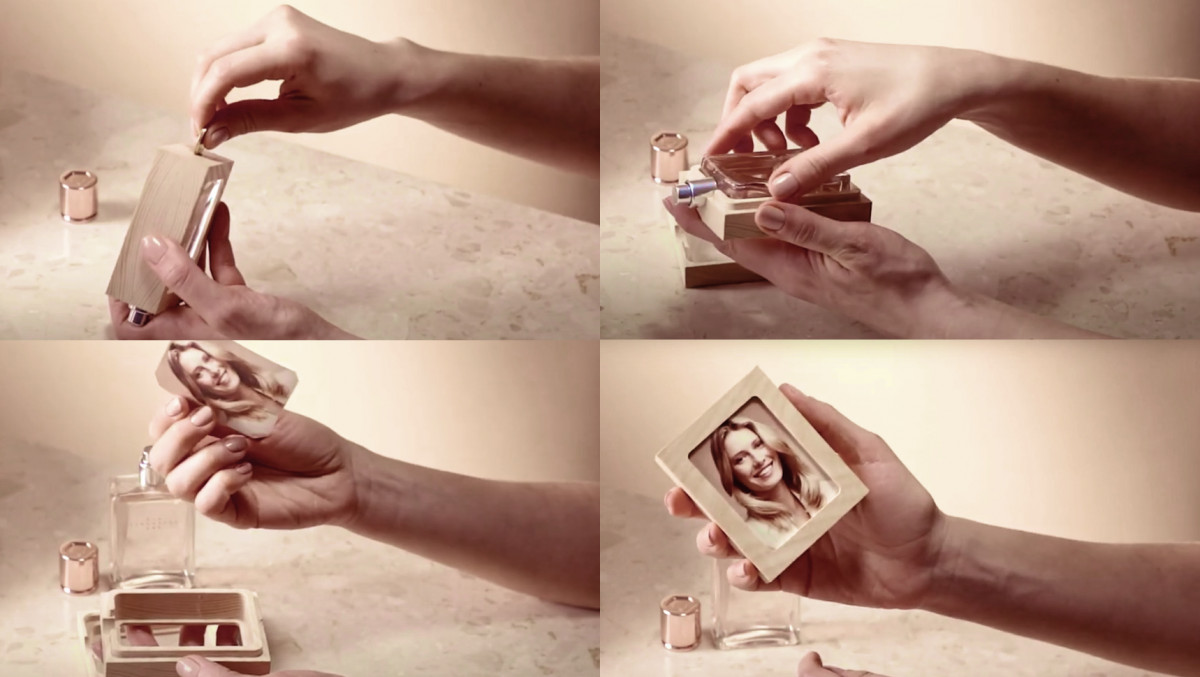
“It’s important to keep that as easy as possible for the consumer. And that was shown on the [Oriflame Signature] secondary pack as well… the secondary carton describes how you can separate it [the bottle] out of the frame.”
This is backed-up by a video on Oriflame’s website likewise instructing its customers how to dismantle the pack simply and repurpose it as a frame.
Another eco tick-in-the-box is that, although the ‘his’ and ‘hers’ bottles are different sizes, they both fit the same frame and pack size.
As Joscelyne explains: “The flacons, the ‘his’ and ‘hers’ bottles, are different volumes, but have been designed so that they have the same footprint, so that one frame can work for both bottles, which obviously provides savings on cost-of-goods and tooling, but there’s also an element of saving resources too.”
Greenwood explains that Butterfly Cannon uses an in-house tool it developed called Conscious Design: a step-by-step process to help clarify a brand’s purpose and define its sustainability goals.
It uses a ‘Climatic Table’ based on the periodic table, featuring 28 sustainable design elements grouped under ‘resources’, ‘manufacturing’, ‘distribution’ and ‘closing the loop’. “Sustainability is such a massive area, so, if you’ve got multiple people in a room and everyone’s got their own opinions, it’s useful having that checklist for our clients and us as a design agency,” explains Greenwood.
FAMILY MATTERS
Of course the Signature fragrance ‘story’ of working alongside loved ones for a better future encompasses more than just green themes, which is why the ‘his’ and ‘hers’ bottles and outer packs have been designed with complementary embossed and debossed panels, allowing them to nestle into one another. The generational aspect, meanwhile, was reflected in the interconnection of both traditional serif and contemporary sans serif fonts in the brand word mark. “The brand identity was created from [using] the more classic Serif typeface and then Sans Serif working together but in quite a disruptive way… so it has a bit of a tension there between old and new,” adds Joscelyne.
SECOND LIFE IDEAS
The Oriflame project is not the first time Butterfly Cannon has worked with a beauty brand on a packaging project of this kind.
The agency previously partnered with Voya, the organic spa and beauty brand, on bags, pouches and tins for Voya’s first seasonal collection. The packs were either created using 100% recycled or recyclable materials, and made to be repurposed.
Similar concepts have also been applied to Butterfly Cannon’s drinks industry clients Tanqueray and Bulleit Bourbon.
The agency’s solution for the Kentucky bourbon whiskey brand’s disruptive outer pack was a customised canvas Lewis Bag: a small, watertight sack with triple-stitched seams into which ice is poured then pounded with a mallet to create the crushed ice for cocktails.
Meanwhile, for a special edition of gin legend Tanqueray’s Tanqueray No Ten, Butterfly Cannon designed a ‘caged bottle’ pack.
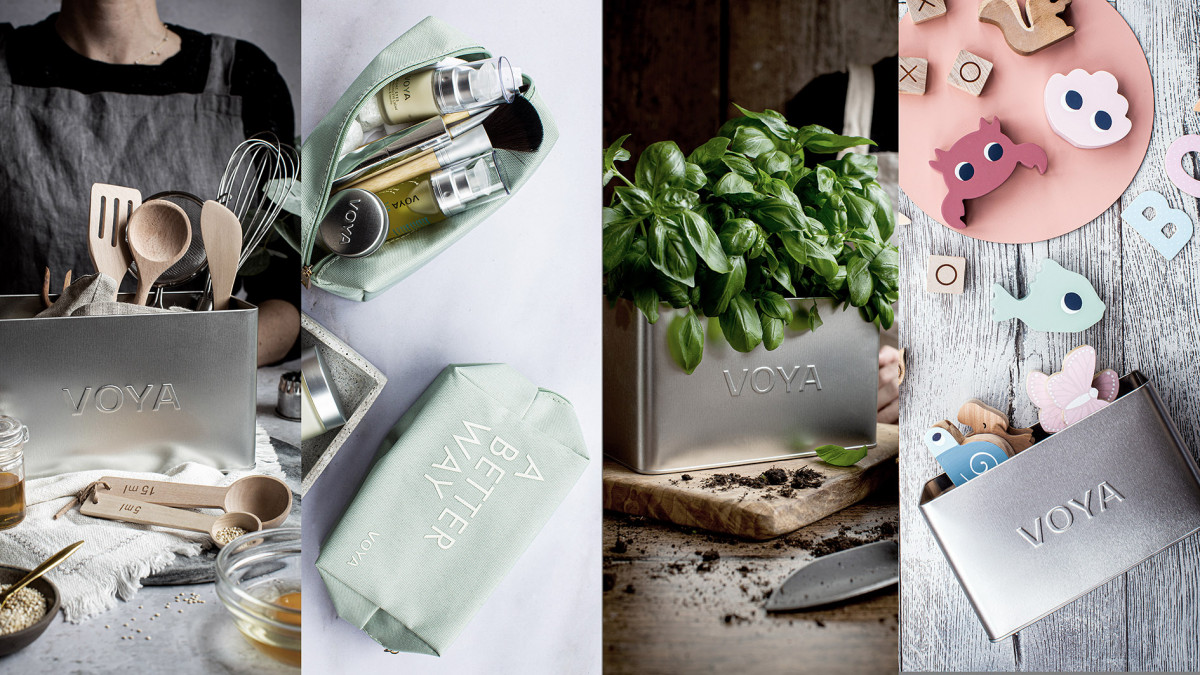
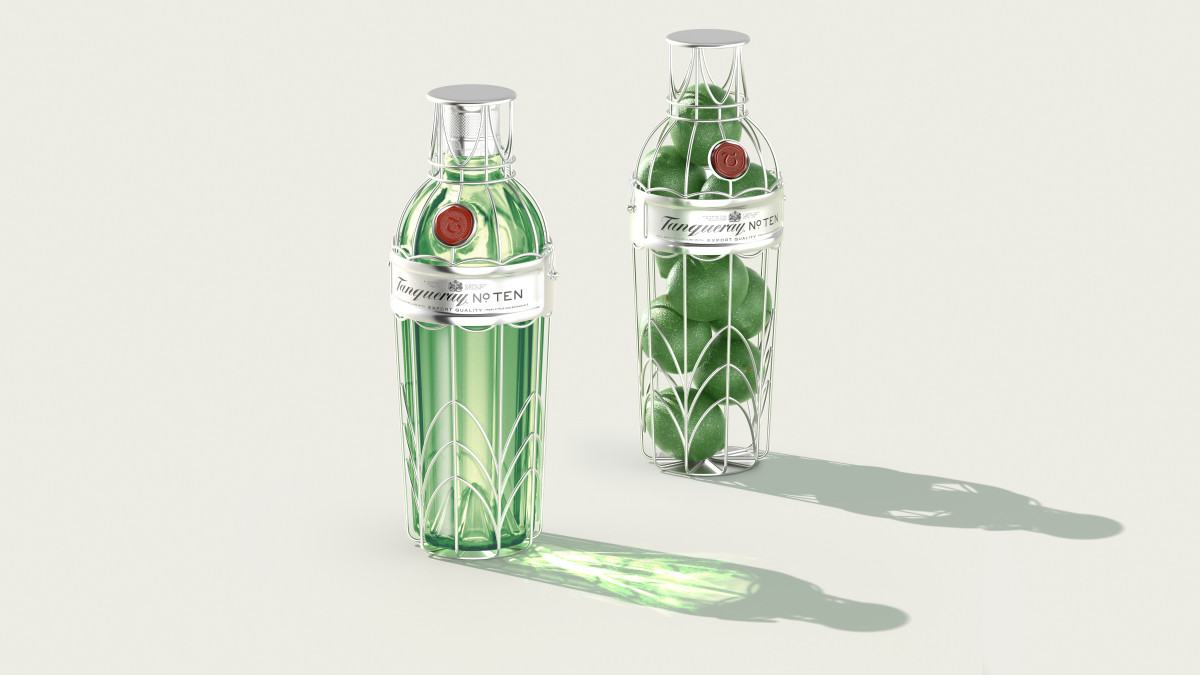
As Joscelyne explains: “It’s a cage for the bottle and the idea was that it was emphasising all of those Art Deco details: that roaring 20s vibe that’s in the brand’s DNA. And it can be used as a holder for citrus fruit, for limes, which you need for gin, but which is also part of the Tanqueray No Ten story, as it’s infused with citrus botanicals.
“And that’s part of the key you need to consider when you’re designing these second life project products. Because it’s sitting there representing the brand, potentially forever. Well, maybe not forever! But it needs to link to the brand story.”
REUSE, REPURPOSE OR BOTH?
So, is the second life strategy the right approach for limited-edition or even permanent products in your brand portfolio?
Or is there a reason why the refillable approach is garnering greater attention? “I love refills and I think that they’re a great way of working, as long as you’re using that with the correct product,” says Greenwood.
As with repurposing concepts, Greenwood suggests companies look at their positioning and customer base before opting for refills. “Do you have the brand loyalty where people will keep buying it?” she asks. “Otherwise, how do you know how many times people are going to reuse this pack? Or are you just adding in more additional materials which mean if this is going to be chucked away, it can’t be recycled easily?”
Joscelyne jumps in to add that, if you’re a newcomer or establishing a new brand concept, “you’re not going to be going in there with brand loyalty and people necessarily going ‘I love this, I’ll come back’. So there is that need to get the brand established”.
Greenwood notes that, for the Oriflame project, whilst the scenario of having the frame and refillability was discussed extensively, within the time-frame of this particular project, refilling was not an option. She adds that the repurpose concept, unlike refilling, is achievable without additional, time-consuming infrastructure changes. Ultimately however, products that can be repurposed and/or refilled are both on the side of the angels by virtue of avoiding landfill.
“They’re both two examples of an overall movement towards conscious design,” says Joscelyne, who borrows a quote from Annie Leonard, co-Executive Director of Greenpeace USA: “There is no such thing as ‘away’; when we throw anything away, it must go somewhere. “When you’re making something that is repurposable, you can stop it from ever entering the waste stream”.
Original article by Julia Wray for Cosmetics Business Magazine